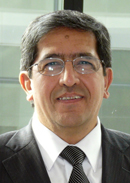
Ten years ago, Noel, Missouri, a small meatpacking town in McDonald County, provided census data that intrigued MU academics, including Domingo Martínez Castilla.
“In 1990, Noel had fewer than 10 Hispanic people in a town of 800 or so,” Martínez said. “When I visited Noel for the first time in 2005, half of the K-8 school students in town were from Mexico or of Mexican descent.”
In the past three decades, immigration by Hispanic people to Missouri has risen dramatically, from 60,000 in 1990 to 213,000 by 2012, according to research data supplied by the Cambio Center. They come for Missouri job openings, as an aging white population retires and younger people leave the state for other professional opportunities. The demographic changes were noticed by MU Extension county office leaders, who asked the University of Missouri to help newcomers adjust to their communities.
The response led to MU’s Cambio de Colores (Change of Colors) conference, which led to the founding of the Cambio Center in 2004.
Faculty, Graduates Provide Research
“Cambio” is Spanish for “change,” which is at the heart of the center’s mission and approach. The center researches the changing demographics in Missouri and the resulting changes to culture, politics and economic development. But the center is not limited to studying Hispanics. All community ethnic groups are studied and can benefit from the work, said Martínez, an agricultural economist research associate in the College of Agriculture, Food and Natural Resources’ International Programs.
Besides Martínez, the center’s other full-time staff member is coordinator Lindsey Saunders. The center has two graduate research assistants and four undergraduate office assistants. At various times, more than 30 MU faculty fellows and four fellows from other institutions have conducted research. Currently four faculty are involved in research projects.
Every year the center organizes Cambio de Colores — Latinos in the Heartland, a three-day conference that brings together researchers, service providers and other stakeholders to address the complex issues related to integrating immigrants into Missouri, the Midwest and other parts of the country. The next conference is June 10–12, 2015, in Kansas City, Missouri.
Getting Grants
Since 2004, the Cambio Center has generated nearly $1.5 million in research grants, Martínez said. In 2006, the center’s first large grant-based research work was undertaken. The goal was to understand the livelihoods of Hispanic immigrants in rural Missouri. The center is completing its second largest research endeavor, started in 2011, to understand the integration of immigrants into small Missouri communities. These projects are multidisciplinary and involve faculty from CAFNR and the College of Education, as well as graduate student assistants from multiple disciplines.
Another research effort addresses the services that USDA offers to Hispanic farmers.
“You only need to make $1,000 from a farming operation to be considered a farmer,” said Eleazar González, a Cambio Center research associate who focuses on economics and sociology. “That’s a gardener. A lot of people don’t know they can qualify for [USDA] support resources.”
González has been working on another grant to fund expansion of immigrant programs on teaching farming literacy.
Programs for Change
In its research, the Cambio Center uses qualitative and quantitative methods and techniques. One is called PhotoVoice. Immigrants snap photographs of things that they feel represent the environment in which they live. In one session, participants were asked to photograph things that make them feel welcome and unwelcome in the communities. Public forums are held to discuss the photos.
“It gives us a way to connect people to the research we are doing,” said Stephen Jeanetta, a Cambio Center associate who focuses on rural sociology. “And it’s a good jumping off point to figure out what they can do to change it.”
Jeanetta has also been involved with the Cambio Center’s health care outreach program, which partners with the Centro Latino de Salud, a Columbia outreach that offers social services to Hispanic people. Center facilitators talk to immigrants about health care services, and nutritionists instruct on the importance of healthful eating.
“We know it works,” Jeanetta said. “But it’s challenging to get the money to fund the program.”
Through January, a display charting the 10-year history of the Cambio Center is on view at the Ellis Library Colonnade.
— Alaina Lancaster and Mark Barna